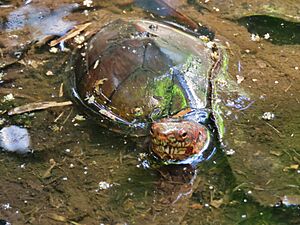Tabasco mud turtle facts for kids
Quick facts for kids Tabasco mud turtle |
|
|---|---|
 |
|
| In Belize | |
| Conservation status | |
| Scientific classification | |
| Genus: |
Kinosternon
|
| Species: |
acutum
|
| Synonyms | |
|
|
The Tabasco mud turtle (Kinosternon acutum) is a small turtle. In Tabasco, Mexico, people often call it pochitoque. This turtle is part of the Kinosternidae family.
You can find this turtle in central Veracruz and Tabasco in Mexico. It also lives in northern Guatemala and Belize. The Tabasco mud turtle prefers small streams, marshes, and ponds. It mainly eats meat and is active at night. Even though it doesn't live in many places, it can be quite common in some areas. In Tabasco, this turtle is important in local culture. People also eat it, even though it has a special protected status.
The Tabasco Mud Turtle in Culture
In the southern Mexican state of Tabasco, this turtle is very important. For a long time, the Chontal people have used it in their traditional cooking. The pochitoque is popular in Chontal communities. Many restaurants that serve local food also use it.
People often roast the pochitoque. Then they eat it in a green soup with rice. This dish is called "pochitoque en verde."
Legends and Art
The pochitoque is a main character in some Chontal legends. One story says that if a crocodile eats a pochitoque, the turtle eats the crocodile from the inside. This way, the turtle survives by killing the crocodile.
Because of these stories, the pochitoque inspires artists. Some poets and singers from Tabasco write poems and songs about it. There is even a special dance called the "dance of pochitoque." A famous song from Tabasco, "Pochitoque Jahuactero," tells a story. It warns a pochitoque to be careful when leaving its swamp.
Protecting the Tabasco Mud Turtle
This turtle is vulnerable because people eat it. Also, it lives in a limited area. Hunting and eating this turtle is not allowed. However, some people still catch them illegally. The pochitoque has even been found in illegal trade between countries.
According to Mexican laws, this species has a special protected status. Many groups work to protect this turtle. They also help with its conservation. In some parts of Mexico, communities are creating special places called hatcheries. These hatcheries help to keep and increase the number of these turtles.


